
by Jamie Sherfy | Nature, Plants
The Chinese Evergreen, or Aglaonema, is a popular low-maintenance houseplant known for its attractive foliage and air-purifying properties. It thrives in low to bright indirect light and requires minimal care, making it ideal for beginners. However, it is toxic to pets and should be handled with caution.

by Jamie Sherfy | Nature, Plants
The Walking Crow’s Guide highlights key information on Yucca plants, known for their low-maintenance care and aesthetic appeal. These mildly toxic plants thrive in well-draining soil and prefer bright, indirect sunlight. They also enhance indoor air quality. Various species are suited for both indoor and outdoor environments.
by Jamie Sherfy | Nature, Plants
The Walking Crow Join The Walking Crow at Bluebelle Local Mercantile in Columbus GA –
2301 Airport Thruway Columbus, GA 31904 –
11am to 4pm

by Jamie Sherfy | Nature, Plants
The Walking Crow Blog features a guide to house plants and gardening, offering comprehensive resources for both novice and experienced gardeners. It aims to help transform living spaces into green oases. Alongside the guide, the blog showcases its latest posts, covering various topics within the gardening spectrum.

by Jamie Sherfy | Nature, Plants
The Cathedral Cactus, or Euphorbia trigona, is an attractive, columnar succulent native to Central Africa. It thrives in USDA Zones 10-12, requires well-draining soil, and prefers bright light. Although it grows quickly and can reach impressive heights, it is toxic and should be handled with care due to its milky sap.

by Jamie Sherfy | Nature, Plants
The Cast-Iron Plant, known for its hardiness and low-maintenance needs, thrives in low light and poor conditions, making it suitable for busy lifestyles. Native to southern China and Japan, it is non-toxic and has minimal care requirements, growing well indoors and in shaded outdoor areas.

by Jamie Sherfy | Nature, Plants
The Bunny Succulent, known scientifically as Monilaria obconica, is a popular succulent native to South Africa, characterized by its fuzzy leaves resembling bunny ears. It thrives in well-draining soil, needs ample sunlight, and requires minimal watering. The plant is non-toxic and contributes to a healthier indoor atmosphere.

by Jamie Sherfy | Nature, Plants
The Bunny Ears plant, or Opuntia microdasys, is a low-maintenance succulent native to Mexico, characterized by its flat, oval pads that resemble bunny ears. It thrives in USDA Hardiness Zones 9-11, requires well-draining soil, and is drought-tolerant. While non-toxic, handle with care due to tiny spines.

by Jamie Sherfy | Nature, Plants
Bromeliads, part of the Bromeliaceae family, are diverse plants known for their striking foliage and vibrant flowers. They thrive in warm, humid environments and need well-draining soil. Most are non-toxic and offer air-purifying benefits. Bromeliads require minimal care, making them suitable for plant enthusiasts of all levels.

by Jamie Sherfy | Nature, Plants
The Jade Plant (Crassula ovata) is a popular succulent known for its thick leaves and tree-like structure, often symbolizing good fortune. Originating from South Africa, it’s mildly toxic to pets. It thrives in well-draining soil, indirect sunlight, and requires careful watering. It’s easy to propagate and maintain for indoor gardens.









